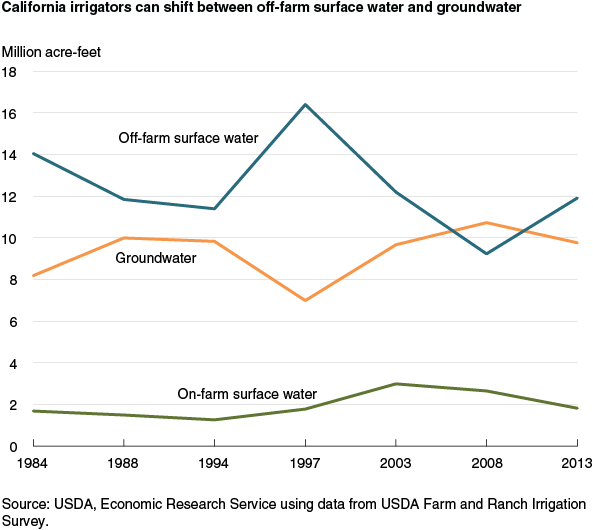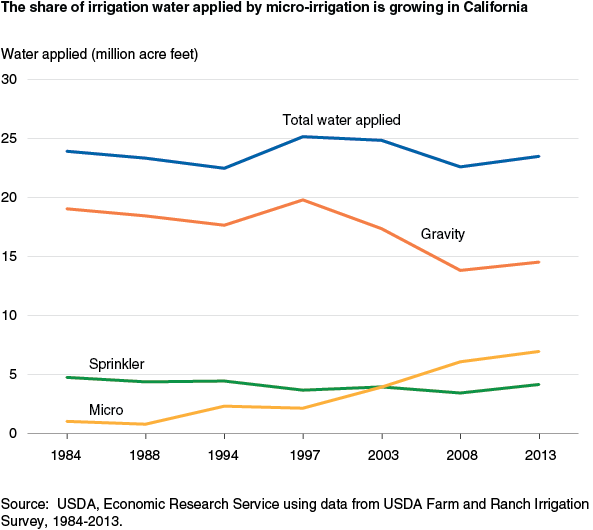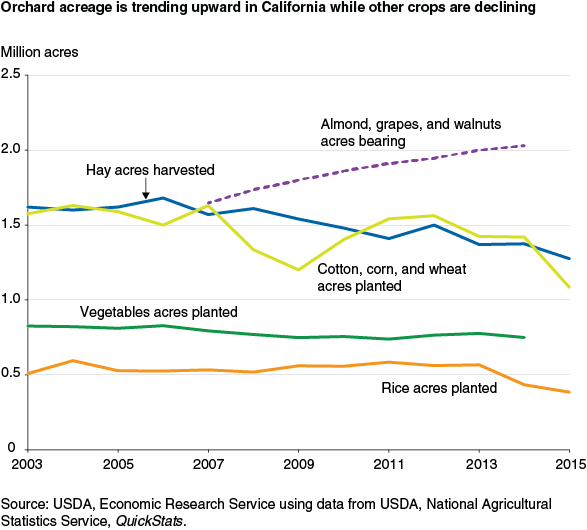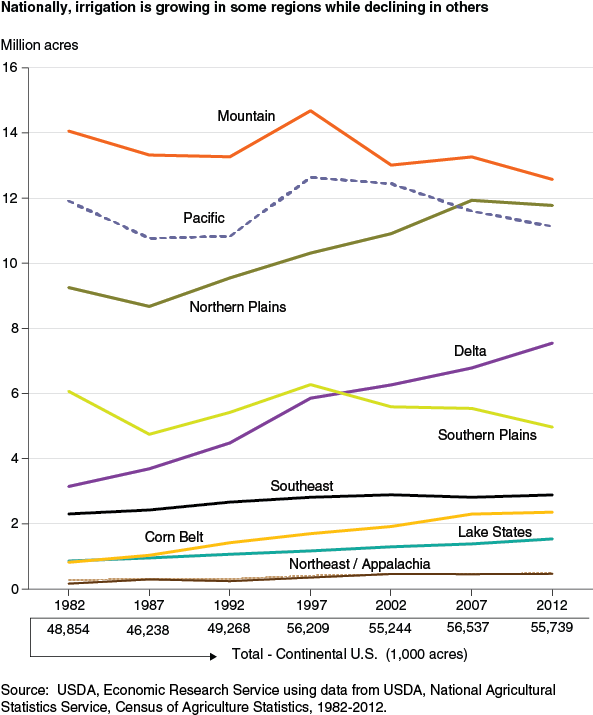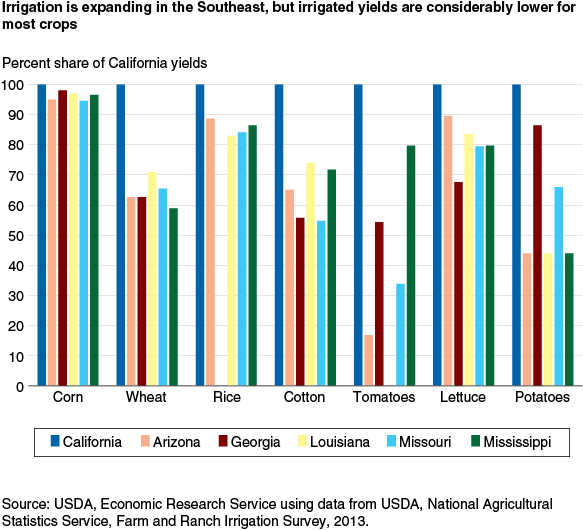Long-Term Response to Water Scarcity in California
- by Steven Wallander, Marcel Aillery and Glenn Schaible
- 11/2/2015
California has a highly variable climate, and severe droughts occur there with considerable frequency. The current 4-year drought is, by almost any measure, the most severe since detailed recordkeeping began in the late 1800s. Given such severe shortages in surface-water availability, agricultural production in California is currently heavily focused on the shortrun challenge of finding the right mix of planted acreage reductions, deficit irrigation, and increases in groundwater withdrawals on the State’s 7 to 8 million irrigated acres.
While the shortrun water shortages of this drought are surprising, sort of like a bad role of the dice, California farmers also face water scarcity as a longrun challenge. The latter challenge, which generally receives less attention than the current drought, stems from a combination of rising competition from other water uses, reduction in groundwater supplies, and climate change. Putting the response to the current drought in perspective requires information on how the longer run challenge continues to reshape irrigated agriculture in California. In this article, we examine long-run change in California’s irrigated agriculture by using data from the USDA Farm and Ranch Irrigation Survey as well as USDA, National Agricultural Statistics Service (NASS) crop acreage and yield reports.
During a drought in California, the shortfalls in water for irrigation come primarily from reductions in off-farm surface-water supplies (e.g.: rivers and reservoirs). Over the long run, total use of off-farm surface water for irrigation is declining, from about 14 million acre-feet in 1984 to about 12 million acre-feet in 2013. Part of this is due to increased competition from other uses—urban demands, cooling water for electricity power generation, and environmental uses such as in stream flows for endangered or threatened aquatic species. Also, water usage varies a great deal from year to year. Irrigators in California applied over 16 million acre-feet of off-farm surface water in 1997, which was possible because of above-average precipitation in the State, including snowpack in the Sierra Mountains, from 1995 to 1999. In contrast, the prolonged drought from 2007 to 2010 made off-farm surface water highly scarce, and so farmers in California applied less than 10 million acre-feet of off-farm surface water in 2008. However, an important facet of irrigation in California is that surface water and groundwater are, to a large degree, substitutes. When off-farm surface water use goes down, groundwater use usually goes up, and vice versa (fig. 1). There is also some adjustment from onfarm surface water—mostly local precipitation captured in small ponds and reservoirs—which is not a particularly large potential source of water compared to the Sierra snowpack, Federal and State reservoirs, or the major aquifers.
One response by California farmers has been to increase investment in more-efficient irrigation systems, such as low pressure sprinkler and micro-irrigation systems that reduce water lost to evaporation, runoff, and deep percolation, thereby increasing the share of applied water that is beneficially used by the crop. Over the past 30 years, the share of irrigation water applied using the (typically) less-efficient gravity systems has declined while that applied by micro-systems has increased.
Over both the long run and the short run, California farmers have also reduced irrigated acreage in response to water scarcity. This reduction has not been equal across crops, however. Higher value perennial crops with high capital costs, such as nut and fruit orchards, have actually increased in irrigated acreage. Lower value crops, such as cotton and hay, which may be more water intensive, have decreased in irrigated acreage.
Of course, scarce water is only one factor driving these acreage shifts. The net effect of a complex mix of economic, policy, and environmental factors, including commodity price changes, has been a regional shift in irrigated production. While total acres irrigated have decreased in California, other regions—most notably the Mississippi Delta and the Northern Plains—have seen significant expansion in irrigated acreage over the past two decades. Extended periods of severe drought in California raise questions about whether greater shifts in irrigated acreage in response to regional water-supply differences are likely, possibly to more humid areas such as the Southeastern United States. However, the relative comparative advantages of regional production remains an important consideration. For example, not all of the increases in other regions’ irrigation acreage reflect a relocation of crops from California. Much of these increases have been in soybeans and corn for grain; soybeans are not a major crop in California, and most of the corn in California is grown for silage (fermented, high-moisture stored animal feed) for dairy cattle. While California agriculture faces increasingly extreme periods of water scarcity and greater competition for water, it continues to benefit from an abundance of high-quality soils and favorable weather conditions. This is evidenced in a comparison of irrigated yields for crops grown both in California and in the Southeastern United States. In most cases, the irrigated yields in California are 30 to 100 percent higher. In addition to differences in productivity, groundwater management and overdraft are concerns in both California and the Southeast.
This article is drawn from:
- Irrigation & Water Use. (n.d.). U.S. Department of Agriculture, Economic Research Service.



